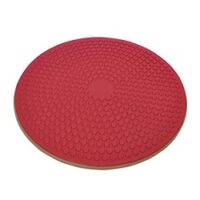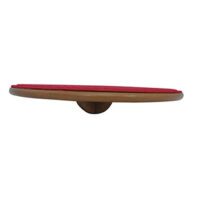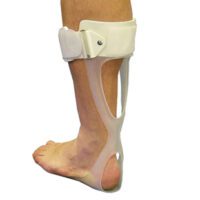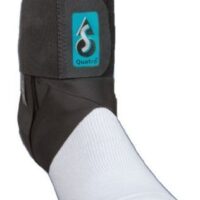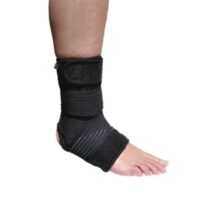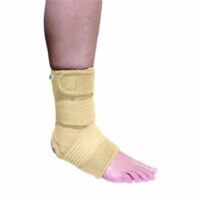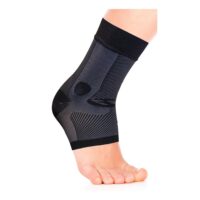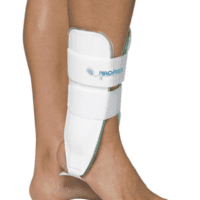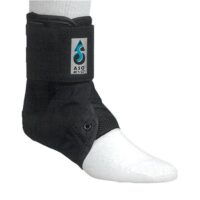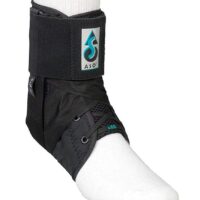Ankle Strapping
Article by John Miller

Ankle Strapping Technique
How to Strap an Ankle
Introduction
Ankle injuries are commonplace, especially in sports. As a physiotherapist, I advocate for ankle strapping as a proactive approach. This article provides insights into ankle strapping, its advantages, and the latest research.
Significance of Ankle Strapping
Ankle taping is crucial in both preventing and treating ankle injuries. Its key function is to lessen the chance and severity of injuries, notably sprained ankles. Recent research indicates that proper ankle strapping can decrease the incidence of ankle sprains in sportspeople.
Choosing the Right Strapping Tape
The most effective ankle taping utilises rigid sports tape. A width of 38mm is usually adequate, though larger ankles might need 50mm width. It’s advisable to avoid 25mm tape as it can be too restrictive.
Ankle Strapping in Sports
In professional sports, where players are substantial investments, clubs often use ankle strapping as injury insurance. This practice is less common in amateur sports, but it’s equally crucial. Amateur sportspeople face similar injury risks and should consider strapping to prevent absence from work and costly medical bills.
Ankle Strapping Technique: Step-by-Step
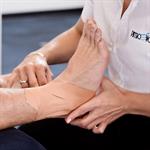
Step 1: Attach Anchors and Stirrups
Start by attaching anchors and then stirrups in a U-shaped pattern from the inside to the outside of the ankle.
Step 2: Figure-6 Taping
Wrap the tape in two figure-6 patterns around the foot to counter inversion movements that can cause injury.
Step 3: Half-Heel Lock
This step provides extra support to the rear ankle area. The tape should start on the inside of the lower leg, move across the ankle, and then under the foot at a 45° angle.
Step 4: Secure with Elastic Adhesive Bandage
Finally, overwrap with a 50mm Elastic Adhesive Bandage in a figure-8 pattern for mild compression and securing.Recent Research
New developments in taping techniques emphasise the need for customised methods. Tailored taping methods based on an individual’s specific ankle anatomy and sport can improve effectiveness.
Prevention Over Cure
The saying “prevention is better than cure” is particularly relevant for ankle injuries. Regular strapping can play a vital role in injury prevention, especially for sportspeople in high-impact sports like football, netball, basketball, and hockey.
Conclusion
Ankle strapping is a valuable method for preventing and managing ankle injuries, essential in both professional and amateur sports. Understanding the correct techniques and using suitable materials can significantly reduce the risk of injury.
Note: This article serves as a general guide and does not substitute professional medical advice. Always consult a healthcare professional for individualised care.
For more information and resources, visit PhysioWorks Ankle Injury Articles.
Seeking Professional Advice
Consulting a qualified physiotherapist for personalised strapping techniques and injury prevention strategies is crucial.
Rochedale - Call 38410277
Book Online: RochedaleSalisbury - Call 32751044
Book Online: SalisburySandgate - Call 32691122
Book Online: SandgateCommon Causes of Ankle Pain
Introduction
Welcome to our detailed guide on the common causes of ankle pain. As physiotherapists, we understand how various conditions and injuries can lead to discomfort in your ankle. From sprains to degenerative diseases, this guide aims to provide clear insights for the general public on navigating these issues.
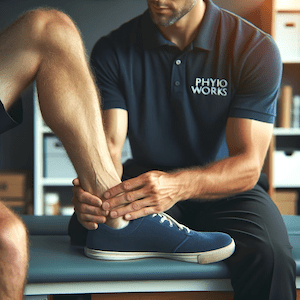

Sprained Ankles and Syndesmosis Injuries
Sprained ankles, including syndesmosis injuries, are among the most common issues we encounter. These injuries can range from mild ligament stretches to severe tears, impacting your mobility and quality of life. Understanding the specifics of each type is crucial for effective treatment and timely recovery.
Ankle Tendinopathies
Tendinopathies, such as those affecting the Achilles and tibialis posterior tendons, are common in active individuals. These conditions arise due to overuse or trauma, leading to pain and swelling in the affected area. Targeted physiotherapy can significantly aid in recovery and prevent future injuries.
Posterior Ankle Conditions
Conditions like posterior ankle impingement and retrocalcaneal bursitis can cause significant pain, especially during physical activities. Recognising these conditions early and starting appropriate treatment is vital for maintaining ankle health and functionality.
Ankle Arthritis
Arthritis in the ankle, often a result of wear and tear or injury, leads to joint pain and stiffness. Early intervention and proper management, including physiotherapy, are essential to slow its progression and manage symptoms effectively.
Biomechanical Conditions
Abnormal foot and ankle biomechanics can lead to various issues, from pain during weight-bearing to nerve compression. Understanding and treating these conditions are crucial for restoring normal function and preventing further complications.
Systemic Conditions That May Cause Ankle Pain
Systemic diseases such as rheumatoid arthritis can manifest as ankle pain. It's important to address these underlying conditions to effectively manage ankle symptoms.
Conclusion
Ankle pain can arise from a multitude of causes, each requiring a unique approach to treatment. If you're experiencing ankle discomfort, we recommend consulting a physiotherapist or doctor for a thorough evaluation. A personalised care plan can significantly improve your quality of life and mobility.
Related Articles
- Sprained Ankle Treatment & Recovery Guide - This article provides comprehensive information on managing pain and inflammation for a sprained ankle, including initial RICE steps and exercises for restoring mobility.
- Anterior Ankle Impingement: Causes, Treatments, Tips & Guide - Offers insights into the causes of anterior ankle impingement, its treatments, and practical tips for management.
- Posterior Ankle Impingement: Causes & Treatments - Explains the condition of posterior ankle impingement, its causes, and available treatment options.
- Tibialis Posterior Tendinopathy - Discusses the condition affecting the tibialis posterior tendon, symptoms, and implications for foot arch pain and ankle stability.
- Achilles Tendinopathy - Answers frequently asked questions about foot and ankle pain associated with Achilles tendinopathy and provides an overview of tendon injuries.
- How To Strap An Ankle - Guides on the correct techniques and types of tape for ankle strapping to prevent or manage ankle injuries.
Rochedale - Call 38410277
Book Online: RochedaleSalisbury - Call 32751044
Book Online: SalisburySandgate - Call 32691122
Book Online: SandgateFoot, Ankle & Heel Pain FAQs
Introduction
Welcome to PhysioWorks' comprehensive FAQ page on Foot, Ankle, and Heel Pain. Our expert physiotherapists are here to guide you in managing and overcoming discomfort. We’ve organised the FAQs into categories, each with a brief overview and links to in-depth articles, making navigation and understanding easier for you.


Foot Pain
Step into the various causes of foot pain and learn effective ways to relieve discomfort. Understand the impact of activities like barefoot running.
Ankle Injuries
Explore common ankle injuries and how to address them. From sprains to ligament damage, find out the best practices for care and prevention.
Heel Pain
Uncover the reasons behind heel pain and the effective treatments available. This section is particularly useful for understanding conditions like plantar fasciitis and heel spurs.
Achilles Pain
Find out how to manage and treat Achilles tendinopathy, a common concern for athletes and active individuals.
Shin Pain
Learn about shin splints, their causes, and how to alleviate this common issue, especially among runners.
Youth Injuries
Gain insights into youth leg injuries, including growing pains and heel issues in children.
Balance & Proprioception
Enhance your balance and proprioception with our professional advice and exercises.
Rochedale - Call 38410277
Book Online: RochedaleSalisbury - Call 32751044
Book Online: SalisburySandgate - Call 32691122
Book Online: SandgateRelated Articles
- Sprained Ankle Treatment & Recovery Guide: Offers detailed advice on how to manage sprained ankles, including immediate recovery steps and physiotherapy treatments.
- Ankle Pain: Effective Management And Treatment Options: Discusses various conditions leading to ankle pain and outlines effective treatment strategies, highlighting the role of physiotherapy in pain reduction and mobility improvement.
- Plantar Fasciitis: Provides an overview of plantar fasciitis, including common causes, treatment options, and related conditions like peroneal tendinopathy and Achilles tendinopathy.
- Achilles Tendinopathy: Focuses on the causes of Achilles tendinopathy, its impact on heel pain, and a range of treatment and prevention strategies.
- Ankle Strapping: Complete Guide To Injury Prevention: Explains the benefits of ankle strapping as a preventative measure against injuries, with a focus on techniques and materials.
- Heel Pain: Explores various causes of heel pain, including tendon injuries, foot injuries, bone injuries, and systemic conditions, alongside recommended treatments.












